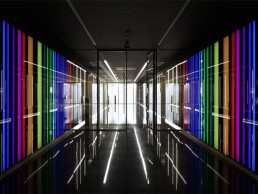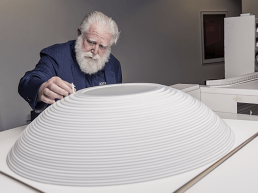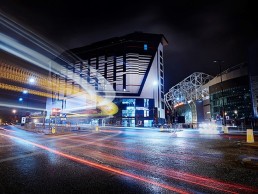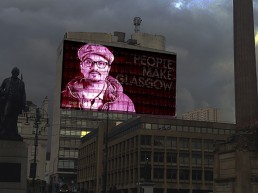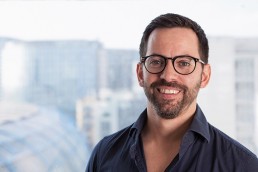Nulty launches bespoke division
(UK) - Lighting design consultancy Nulty has launched a bespoke luminaire design and manufacturing company, Nulty Bespoke, in response to a growing need for customised lighting pieces.
As lighting scheme designers for establishments such as the Royal Albert Hall, Harrods and News Corp HQ, Nulty often requires handcrafted alternatives to off-the-shelf fittings, in order to achieve a delicacy of detail and seamlessness between light and space. With Nulty Bespoke, the practice now has an official in-house division dedicated to such luminaires.
Nulty Bespoke is an effective solution for architects, interior designers and other lighting design practices who are increasingly demanding their own tailor-made fixtures. The Nulty Bespoke team employs world-class designers, sources high-quality materials and works with specialist manufacturers from around the world.
Managing Director Trevor Morgan has 30 years’ experience in the lighting industry, where he’s worked at all stages of lighting and product design – from initial design conception and manufacture to installation and commissioning. “By scratching our own itch, we’re also able to provide our colleagues in the industry with the handcrafted and unique lighting fixtures they desire,” he said.
Company founder Paul Nulty commented: “Our experience in all aspects of the design, manufacturing and installation process means we can create exquisite products on time and on budget – all while retaining continuous quality control.”
The launch of Nulty Bespoke follows a busy and successful year for Nulty, and coincides with the practice’s fifth birthday. Since opening in 2011, the team has grown to become one of the UK’s largest lighting design practices, delivering high-end projects across the retail, hospitality, commercial and residential sectors within the UK and internationally. In 2015, they rebranded in recognition of the strength and expertise of the team – many of whom have worked on some of the largest lighting projects in the UK, as well as in Thailand, Dubai, Abu Dhabi and Russia.
In early 2016, Nulty opened an office in Dubai to deliver its innovative lighting concepts within a market that continues to be progressive in its architectural and interior design aspirations.
Pic: James French
Turrell to take ARoS to next level
(Denmark) - schmidt hammer lassen architects collaborates with James Turrell to take Aarhus Art Museum to ‘The Next Level’.
ARoS Aarhus Art Museum in Denmark, headed by its visionary director Erland G. Høyersten, has revealed an ambitious expansion plan aiming to bring the museum into the world elite of modern art museums. "The Next Level" expansion project is leading art towards new ways of expressions and content with an exciting collaboration with world famous American artist, James Turrell. schmidt hammer lassen architects have been chosen to design the new extension to the museum, which contains a 1,200 m2 subterranean gallery and two semi-subterranean art installations, ‘The Sphere' and ‘The Dome', by James Turrell. schmidt hammer lassen are working in close collaboration with the artist designing the €30 million expansion that will merge art and architecture into a new civic experience.
As the architects who originally designed ARoS Aarhus Art Museum, schmidt hammer lassen have had a continuous dialogue with the museum to strengthen the iconic nature of the building. This process has formerly involved collaboration with internationally renowned artist Olafur Eliasson, who designed ‘Your Rainbow Panorama'.
James Turrell is one of the world's leading artists working with light, colours and art installations with permanent installations in over 26 countries. His most famous work is ‘Roden Crater' - an extinct volcano in the Arizona desert, forming the world's largest work of art. His works have the common feature that they embrace the audience through light and colour effects controlled by the artist. Turrell's often colourful room installations are reminiscent of three-dimensional light paintings, where he connects the earthly with the heavenly and body and sense with the mind and thought. The Next Level is his biggest project within a museum context.
After a series of workshops between James Turrell, the museum management and schmidt hammer lassen, The Next Level project was officially unveiled to the public on 30 October 2015. The new extension connects to the existing building, visitors will access the underground artwork via the current special exhibition foyer.
"It is a privilege for me as an architect to have the opportunity to work with James Turrell on this ambitious project. The Next Level project will develop the museum horizontally in contrast to the existing vertical movement and it is exciting to work with the great lines spanning from the river to the square of the Aarhus Music Hall. Our studio is not just designing a new room for a new art work, we are co-creating the space and the installation simultaneously with James Turrell," explained Morten Schmidt, Founding partner at schmidt hammer lassen.
Great things can happen when an artist and architect have the opportunity to collaborate from the outset on a given project. schmidt hammer lassen have always tried to ensure the possibility for a real collaborative effort with local and internationally renowned artists. Some of our creative collaborations include The Royal Library with Per Kirkeby, the Cultural Centre of Greenland with Buuti Pedersen, the International Criminal Court with Eske Rex, Dokk1 with Kirstine Roepstorff, Elmgreen & Dragset and A Kassen, and Nykredit Headquarters with Anita Jørgensen and Per Kirkeby.
Pic: Morten Fauerby-Montgomery
Luxonic expands
(UK) - Design-led lighting manufacturer opens first sales office in Scotland at Tannochside Business Park, Glasgow.
Luxonic, the UK’s leading design-led commercial lighting manufacturer, has expanded its offering with the opening of its first sales office in Scotland. The business’s new Glasgow base will further Luxonic’s already strong operation across the UK, adding to existing offices in Manchester, Belfast and Luxonic’s HQ and manufacturing facilities in Basingstoke.
The office opening, at Tannochside Business Park, Glasgow, follows an impressive 2014/15 financial year for Luxonic, which saw a 47 per cent increase in revenue, with sales hitting £15.5million. The figures represent unprecedented growth for the business, which also saw its net profit increase to £2million.
Commenting on the expansion, Luxonic managing director Nick Tavare, said: “Luxonic has enjoyed exceptional growth over the last year, tied in with significant internal investment that has allowed us to develop unrivalled products for clients across the UK.
“Geographical expansion is an integral part of our growth strategy and we see Scotland as an increasingly important market for Luxonic to promote its offering and grow our reach domestically. With Scotland’s growing cities providing hubs for commercial projects, as well as the wider leisure and industrial markets, we’re looking forward to developing and building on existing relationships to establish ourselves in the region.”
Pics: Recent work from Luxonic - Hotel Football, Manchester and commercial work at Louis Vuitton’s offices in Pancras Square, London.
Glasgow under the microscope
(UK) - Stellar series of events to light up Glasgow during LUCI next week - the last international lighting conference of 2015 UN International Year of Light.
Taking place 11-15 November, the LUCI (Lighting Urban Community International) City Under the Microscope conference in Glasgow is the last international conference on lighting in 2015, the UN International Year of Light, featuring seminars, workshops, an exhibition and a series of events.
These events include NVA's Ghost Peloton Glasgow (now sold-out) at the Whisky Bond in Port Dundas on 12 and 13 November. This is a new iteration of the work originally commissioned for the Yorkshire Festival 2014 marking the Grand Depart of the Tour de France last year. An award-winning short film of Ghost Peloton can be viewed at: https://vimeo.com/108332712. Local volunteers are participating with organisers NVA in all aspects of the performances.
The façade of the City of Glasgow College (former College of Building and Printing) in the city centre will feature large projections, created by Glasgow-born artist Craig Morrison in collaboration with students and staff from the college, between 11 - 15 November. This work, The Glasgow Portrait Project, will show over 150 portraits of the people that make Glasgow. Two other pieces will also be shown on the college façade - LIGHT, by German artists Hartung and Trenz, a piece to mark the UN International Year of Light. Craig Morrison has also collaborated with Hartung and Trenz to create a site-specific artwork, entitled I Love You, an animated sequence that will project the words over 50 metres wide on the building.
The South Portland Street Footbridge will be illuminated by Philips Lighting each evening between 11 - 14 November, and on the evening of 11 November, there will be a walking tour of lighting installations in and around the city centre.
In addition, an exhibition at The Lighthouse - Radiance Reflected - telling the story of lighting in Glasgow over the centuries and how this has evolved, will open to the public on 12 November and run until the Christmas period. Bailie Allan Stewart, a past president of LUCI, said: "These fantastic events will illustrate the beauty that can be created through lighting and I have no doubt they will be a memorable feature of the LUCI conference for Glaswegians and our visitors. From Port Dundas down to the Clyde, next week there will be something amazing to see at night that was made by the use of light."
Speakers in the seminar and workshop programme include Iain Macrae, Head of Global Lighting Applications at Thorn Lighting Group, who will be talking about public lighting for communities in developing nations, and Mark van Doorn, Design Manager at Philips Lighting, who will talk about Glasgow's input to the Liveable Cities programme.
The themes of the conference's seminars and workshops reflect the changing role of lighting in cities and how it features in regeneration, science and innovation, design, sustainability and the green economy, engineering, resilience, the creative industries, tourism, manufacturing, intelligent street lighting, smart cities, and the redevelopment of the Forth & Clyde Canal. There are around 70 member cities in the LUCI network. Around 120 international delegates are expected to attend the conference in Glasgow.
Paul Nulty
Having recently rebranded to Nulty+ mondo*arc speaks exclusively to Paul Nulty on the move towards a new future, why the lighting industry needs a “shake up” and what he plans to do about it...
It’s been three years since we last caught up, what’s been happening?
We’ve really stepped it up a level. The practice has more than doubled in size and we’re being asked to tender some of the largest projects in the UK. It seems like such a short space of time but in that time we have evolved and matured. My aim was always to build a team that’s full of characters and has lots of charisma; I like people who have ideas and who aren’t afraid to express them and the team are really blossoming into cool designers with opinions and a lot of skill sets.
And in the industry – how are things different?
Alongside squeezed budgets, in recent years we’ve seen more demands from clients and the deadlines have been harder and tighter than ever before. While this is not so much the case today, it has played to our advantage because it has given us a great platform for learning; we’ve now got more experience in dealing with pace and we’ve been able to nurture the team in tackling this. As such, we’re in a position where the whole team is able to anticipate customers’ needs and respond much more quickly than before.
The practice is rebranding to Nulty+. Why now?
From day one it was always an aspiration. Having been at Light Bureau for eleven years I wanted to make people aware I was out on my own and calling the practice after myself was the most obvious way. It wasn’t about my ego... I love light, I live and breathe it and am very grateful for the opportunities I’ve had to develop as a lighting designer. I want to create a legacy and would love the practice to become a nursery for the future industry. I always wanted to depersonalise the practice from myself and we’ve now got to the point where it doesn’t really need me - the right people are in the right places. Nulty+ signifies a celebration of what we’ve achieved and a team of people who are experienced, energetic and charismatic – in reality, I’m just a cog in a bigger machine!
How have you prepared your team for life as lighting designers?
I’m very demanding in what I expect from them! We don’t pigeon hole people, and we try to expose the team to as much project experience with the support of the more senior members. It’s about making all of the team an integral part of a project and we encourage staff to take ownership as much as possible.
“Anyone can become a lighting designer”, is this something you truly believe?
Yes and no. You’ve got to have a creative eye and a passion for lighting – but everything else can be taught - sharing knowledge will improve our industry. Historically, there’s been a reluctance to share information between rival practices, but to me the ‘old school’ days are changing. Some in the industry don’t like manufacturers calling themselves lighting designers, I’m the opposite - if it’s a good piece of lighting design delivered on time and on budget then what’s the issue? I would rather lighting design was done well regardless of who undertakes it – it’s more about education. Today’s generation is really interesting, there’s more willingness to share – this is a lot to do with social media. It has changed the way we communicate and I think it’s commendable.
Is this part of your aim to “challenge the status quo”?
We need to professionalise our business like other creative industries do. Many agencies are set up by designers who didn’t really intend to become business people, or actually want to – they wanted to design and be creative. But I would like the industry to become more educated in the way its practices are administered. There are companies out there that do it very well, but there are others that lurch from project to project, slashing fees and delivering a poor service. This undermines the industry. I really believe one of our differentiators is the level of service and the way we work with clients; our aim is to make it fun and collaborative. Challenging the status quo means challenging the way the industry presents itself as well as challenging the reasoning. I want us to be a leading voice in that and the new philosophy we’re bringing with the rebranding is going to be central to this.
What do you think the lighting industry is lacking?
One of my frustrations with lighting awards is that while beautiful projects are rewarded no one ever stops to think about whether the project was delivered on time and on budget and whether the lighting designer went bust in the process. We really need to start looking at the way we present ourselves professionally and if all we’re doing is cutting our throats in terms of fees and throwing work out of the door we’re never going to be treated as equals around the table with architects and interior designers. Most lighting education in the UK is geared towards engineering and not design but we need to focus more on the emotional concept that lighting brings to a space, not just the functional.
Is Speirs + Major status something you aspire towards?
Not just Speirs + Major, there are many other good lighting design practices and we would love to be counted amongst them. Our aim is for us to be at the pinnacle of our industry and who knows, even surpass them. I want Nulty+ to become a practice that in years to come, people talk about. As mentioned, it’s about creating a legacy rather than looking at where we are now – it’s about living and planning for the future of the business.
You’re well-known for your retail lighting - what does the future hold?
Retail lighting actually only makes up about 25% of our business but yes, I absolutely want to remain at the forefront of retail design as we’ve worked hard to get there – my team knows it’s important to me to remain innovative. We’ve already completed a lot of projects in a short space of time and we’ve currently got some amazing projects on our books – our client list is pretty extensive! There’s also been a lot of collaboration with clients and other designers - they are buying lighting advice and understanding the need for it a lot more than perhaps they used to. Our designers have got some great opportunities for growth in the industry.
pfarré lighting design makes a move
(Germany) - After seventeen years in Munich’s north-west, Gerd Pfarré's practice moves to stunning office in Schwabing district.
The former antique luminaire store in Munich‘s Alt-Schwabing district provided an ideal L-shaped ground plan for the workplaces and other areas of the new studio. All main technical features, such as print/copy, large-format printer, coffee, server, etc. are hidden behind a new space divider, which also houses the product library and consumable supplies. With this divider, a generous space between divider and the shop windows has been created for meetings and presentations.
Thanks to the digitalisation of the working process and archives, the size of the studio remained the same as before. However, five desks have been reduced in size. An eight-metre long shelving unit provides space to work and store, below a pinboard with the same length. At the former studio site out of town, PLD is still equipped with a lavish archive and further space for testing, mock-ups, and models.
The key lighting elements are four Lichter Trichter pendants found above the workplaces - a special edition of a luminaire designed by Christoph Matthias and Gerd Pfarré. Equipped with two DALI-LED systems for diffuse/direct lighting and indirect lighting (LED 3,000°K diffuse, LED 4,000°K indirect) each generates a perfect task light with lux levels up to 500. Furthermore, the fabric diffusors (dia. 120 cm, removable, washable) optimise the acoustics significantly, as does the pinboard, which is made of soft fibre panels.
Behind the pinboard an LED-profile (3,000°K) provides indirect light for work, testing translucent materials and enhances - with its linear effect - the length of the shelving unit. The back-office is illuminated via the ceiling reflection with indirect LED-strips on top of the upper shelf (6,000°K). The stage lighting effect (backlit quinta) enhances the impact and independence of the space divider in the studio. The extremely cool colour temperature also serves as an example for clients and architects.
In the meeting and presentation area, a track system offers a large variety of direct lighting solutions, such as for projections, tests and experiments. The shop windows are illuminated with two spotlights (6° beam angle, 4W). The entire front space is intended for the presentation of projects, oneoffs, lighting objects as well as to hold meetings and smaller events. The total power consumption for the studio is with 228W highly economical (4,3W/sq metres).


